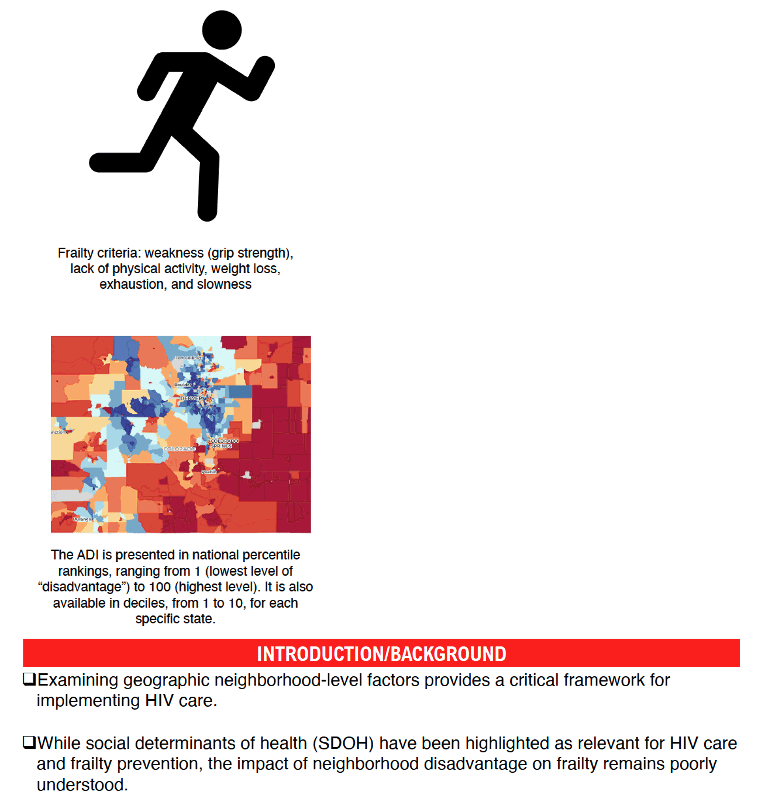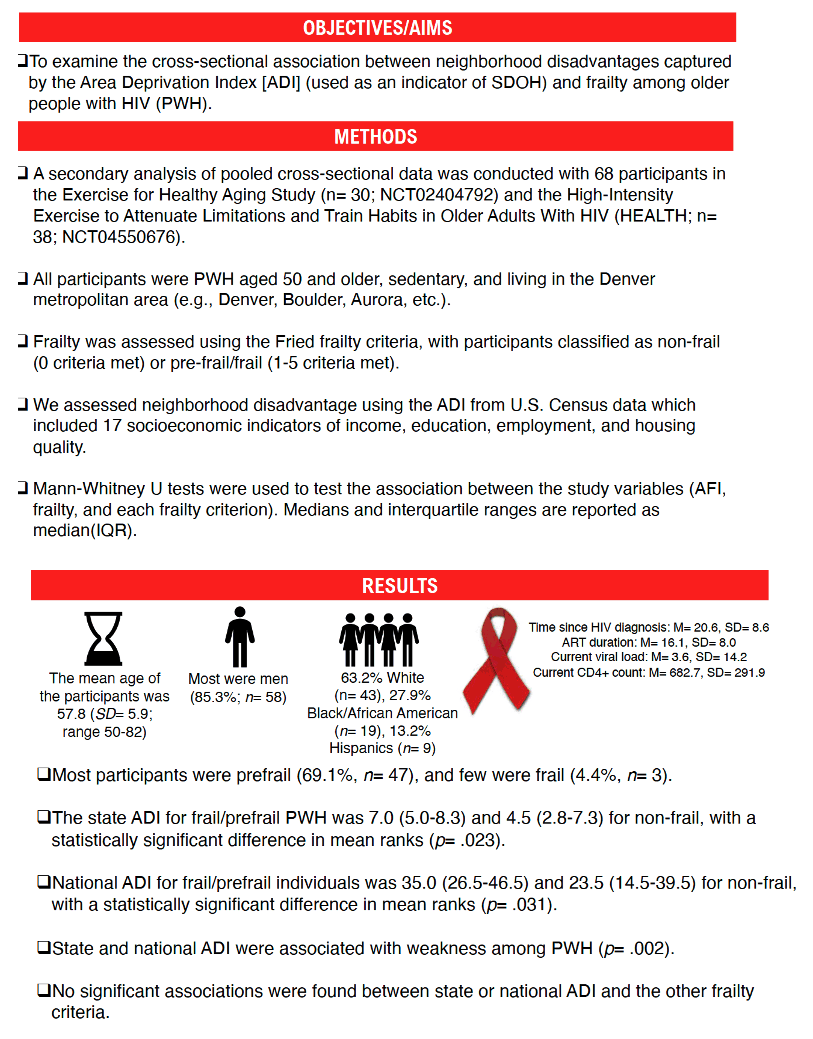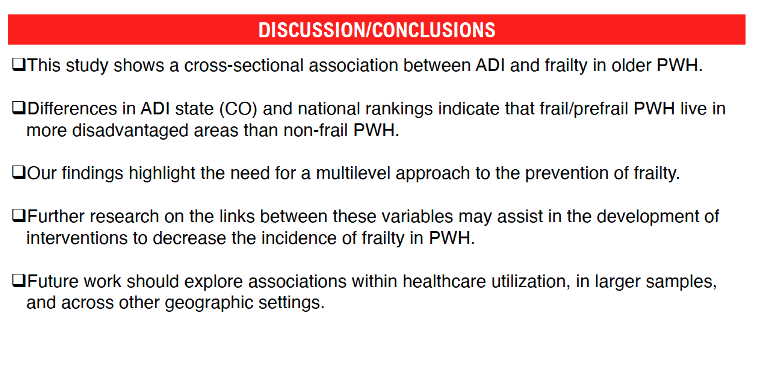 |
 |
 |
| |
Prefrail or frail older people with HIV live in
more disadvantaged areas than older HIV-positive nonfrail people
|
| |
| |
Where You Live Tied to Frailty Rate in Older People With HIV
International Workshop on HIV & Aging 2023, October 26-27, Washington, DC
Reported by Mark Mascolini for Academic Medical Education and NATAP
Prefrail or frail older people with HIV proved more likely to live in a disadvantaged locale-as reckoned by area deprivation index (ADI)-compared with older nonfrail HIV-positive people [1]. Researchers from the University of Colorado Anschutz Medical Campus believe their findings “highlight the need for a multilevel approach to the prevention of frailty.”
Multiple studies indicate higher frailty prevalence in people with HIV than in the general population, often at an earlier age [2]. The Colorado investigators noted that social determinants of health (SDOH) are relevant in preventing frailty, but how the neighborhood where a person lives interacts with frailty remains little studied.
To address that gap in frailty research, these researchers analyzed the potential impact of neighborhood disadvantage estimated by ADI on frailty prevalence in an older HIV population living in the Denver metropolitan area. By marshaling US Census data on 17 socioeconomic indicators, the ADI rates areas from least to the most disadvantaged on a 1-to-10 scale for states and on a 1-to-100 scale for the entire United States. The Colorado team used the Fried frailty phenotype [3] to determine whether a study participant was nonfrail (0 Fried criteria met), prefrail (1 or 2 criteria met), or frail (3 to 5 criteria met). (See reference 3 for criteria.)
The study population of 68 people with HIV came from two exercise studies (ClinicalTrials.gov IDs NCT02404792 and NCT04550676). All participants were 50 or older, sedentary, and lived in the greater Denver area. The group averaged 57.8 years in age (range 50 to 82), 58 (85.3%) were men, 43 (63.2%) white, 19 (27.9%) black, and 9 (13.2%) Hispanic. While 47 participants (69.1%) met criteria for prefrailty, 3 (4.4%) were frail and the rest nonfrail.
On the 1-to-10 state scale, frail or prefrail people had a median ADI of 7.0 (interquartile range [IQR] 5.0 to 8.3), while nonfrail people had a median ADI of 4.5 (IQR 2.8 to 7.3), a significant difference indicating greater area deprivation in the prefrail/frail group (P = 0.023). On the 1-to-100 national ADI scale, frail or prefrail people had a median ADI of 35.0 (IQR 26.5 to 46.5), compared with a less deprived ADI of 23.5 (IQR 14.5 to 39.5) in the nonfrail group, also a significant difference (P = 0.031). Both state and national ADIs were associated with the Fried frailty criterion of grip-strength weakness (P = 0.002), but there were no other associations between ADI and other individual Fried criteria.
The Colorado investigators concluded that both state and national ADI show that prefrail or frail older people with HIV live in more disadvantaged areas than older HIV-positive nonfrail people. They called for further research on possible ties between ADI and frailty to help devise interventions that will lower frailty incidence in people with HIV.
References
1. Iriarte E, Jankowski C, Wilson M, Khuu V, Ditzenberger G, Erlandson K. Frailty and the area deprivation index as indicator of neighborhood disadvantage among older people with HIV in Colorado. International Workshop on HIV & Aging 2023, October 26-27, Washington, DC. Abstract 21.
2. Piggott DA, Erlandson KM, Yaashika KE. Frailty in HIV: epidemiology, biology, measurement, interventions, and research needs. Cur HIV/AIDS Rep. 2016;13:340-348. doi: 10.1007/s11904-016-0334-8. https://www.ncbi.nlm.nih.gov/pmc/articles/PMC5131367/
3. Fried LP, Tangen CM, Walston J, et al. Frailty in older adults: evidence for a phenotype. J Gerontol A Biol Sci Med Sci. 2001;56:M146-56. doi: 10.1093/gerona/56.3.m146. https://academic.oup.com/biomedgerontology/article/56/3/M146/545770 (The Fried frailty phenotype includes 5 conditions: weight loss, exhaustion, low physical activity, slow gait, and weak grip strength. Having 3 to 5 of these conditions indicates frailty, while 1 or 2 conditions indicate prefrailty.)



|
| |
|
 |
 |
|
|